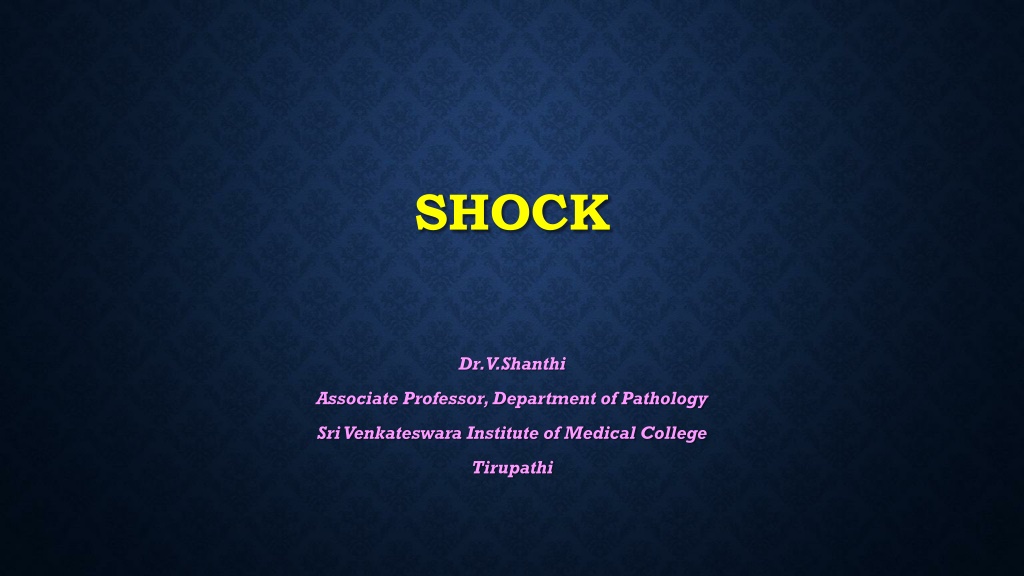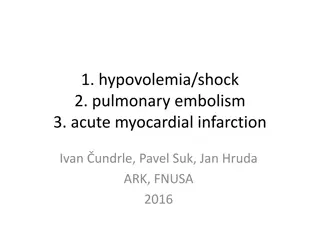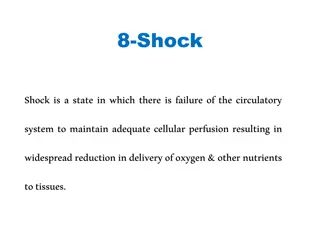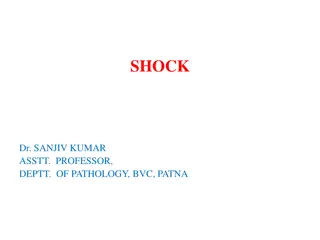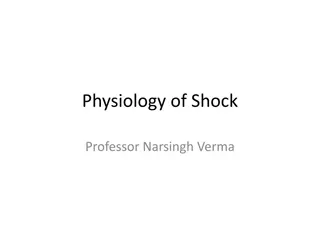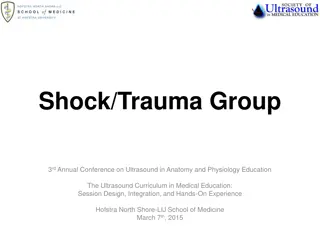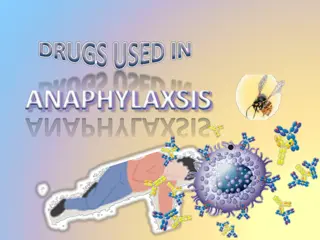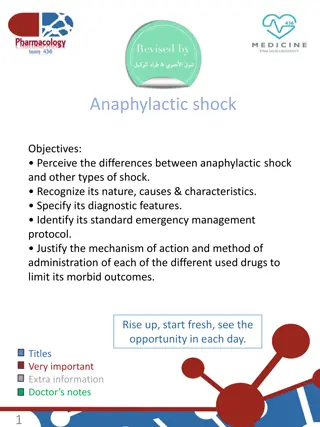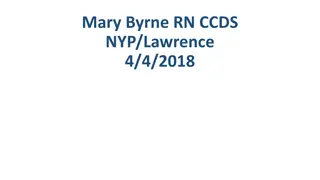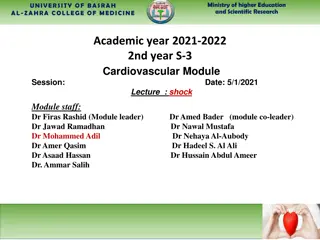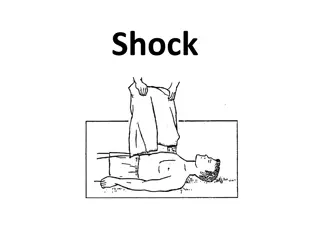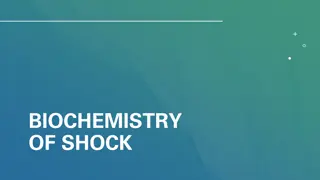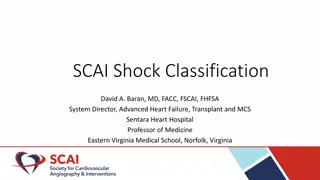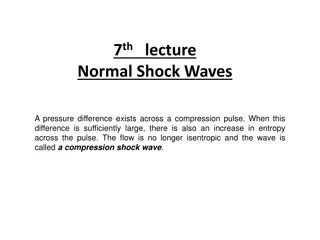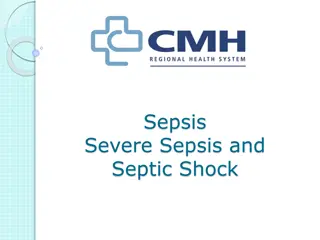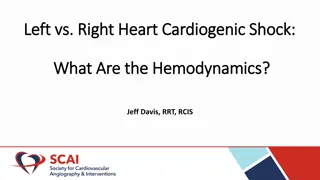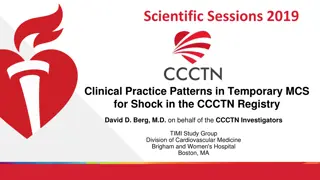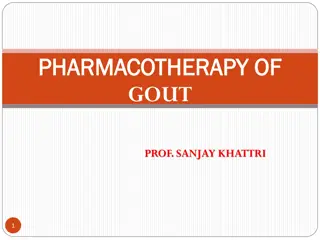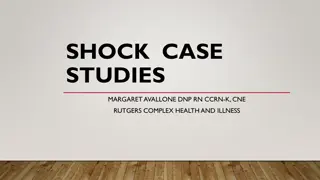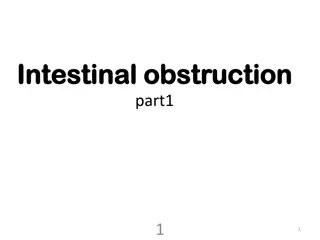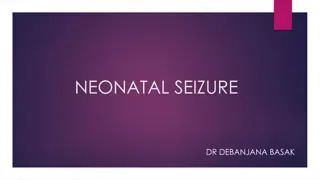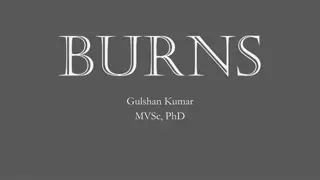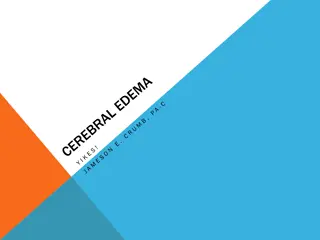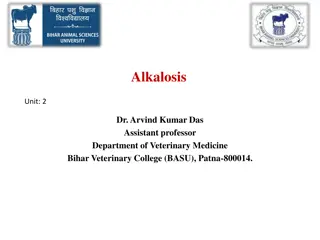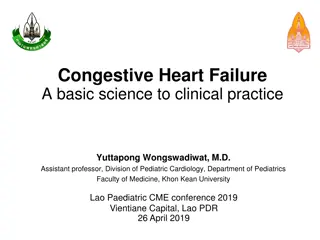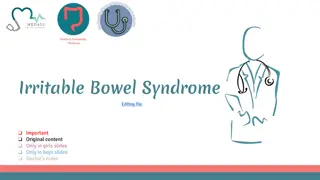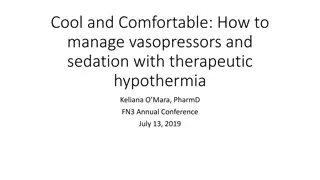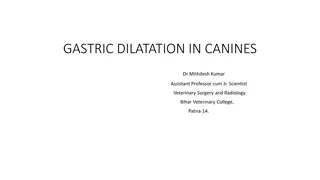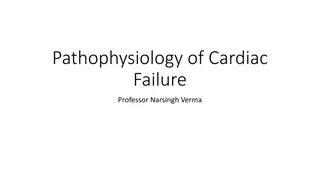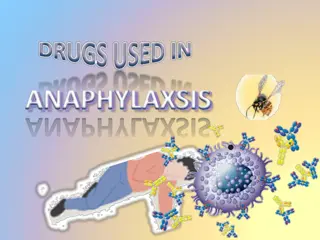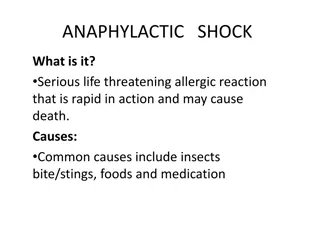Understanding Shock: Types, Mechanisms, and Pathophysiology
Shock, a state of systemic hypotension resulting in impaired tissue perfusion and cellular hypoxia, has various types such as cardiogenic, hypovolemic, septic, neurogenic, and anaphylactic shock. Each type has different mechanisms and causes, leading to decreased cardiac output and multiorgan failure. This article discusses the pathophysiology of hypovolemic shock in detail, highlighting organ dysfunction, decreased preload, and hypotension. Recognizing the different types of shock is crucial for prompt identification and management in clinical settings.
Download Presentation

Please find below an Image/Link to download the presentation.
The content on the website is provided AS IS for your information and personal use only. It may not be sold, licensed, or shared on other websites without obtaining consent from the author. Download presentation by click this link. If you encounter any issues during the download, it is possible that the publisher has removed the file from their server.
E N D
Presentation Transcript
SHOCK Dr.V.Shanthi Associate Professor, Department of Pathology Sri Venkateswara Institute of Medical College Tirupathi
SHOCK Shock is characterized by systemic hypotension due to either reduced cardiac output or reduced effective circulating blood volume This leads to impaired tissue perfusion and cellular hypoxia
SHOCK Types of shock depending on etiology Cardiogenic shock Hypovolemic shock Septic shock Neurogenic shock Anaphylactic shock
CARDIOGENIC SHOCK Mechanism - Results from low cardiac output due to myocardial pump failure Causes - Myocardial damage (M.I) - Ventricular rupture - Arrhythmias - Cardiac tamponade (External compression) - Pulmonary embolism (outflow obstruction)
HYPOVOLEMIC SHOCK Mechanism loss of blood or plasma volume leads to decreased cardiac output and reduced tissue perfusion Causes massive hemorrhage or fluid loss from severe burns
PATHOPHYSIOLOGY OF HYPOVOLEMIC SHOCK HYPOVOLEMIA MULTIORGAN FAILURE Organ dysfunction Decreased venous return Perfusion failure and tissue hypoxia Decreased preload DECREASED CARDIAC OUT PUT Hypotension
NEUROGENIC SHOCK Mechanism result due to anesthetic accident or spinal cord injury which leads to loss of vascular tone and peripheral pooling of blood
ANAPHYLACTIC SHOCK Mechanism in this there is systemic vasodilatation and increased vascular permeability caused by an Ig E- mediated hypersensitivity reaction Acute widespread vasodilatation results in tissue hypoperfusion and hypoxia
SEPTIC SHOCK Definition - Septic shock is defined as hypotension associated with severe sepsis and cannot be corrected by infusing fluids
SEPTIC SHOCK Causes for Septic shock - Overwhelming microbial infections (bacteria and fungi) - Gram positive septicemia - Gram negative bacteria - Fungal sepsis - Rarely protozoa or Rickettsiae
SEPTIC SHOCK PATHOGENESIS Major factors contributing to the pathophysiology include Inflammatory mediators Endothelial activation and injury Induction of procoagulant state Metabolic abnormalities Organ dysfunction Immune suppression
SEPTIC SHOCK PATHOGENESIS Inflammatory mediators Microbial cell wall constituents (LPS) engage receptors on neutrophils, mononuclear inflammatory cells and endothelial cells leading to cellular activation Activated cells produce inflammatory mediators like TNF, IL-1, IFN- , IL-12, IL-18, HMGB 1 (High mobility group box 1 protein), prostaglandins and PAF. These mediators activate endothelial cells which express adhesion molecules They activate complement and coagulation cascade .
SEPTIC SHOCK PATHOGENESIS Inflammatory mediators Complement cascade is activated by microbial components Results in production of anaphylotoxins (C3a, C5a), chemotactic fragments (C5a) and opsonins (C3b) All these contribute to proinflammatory state
SEPTIC SHOCK PATHOGENESIS Inflammatory mediators Microbial components activate coagulation directly through factor XII and indirectly through altered endothelial function Accompanying widespread activation of thrombin may further augment inflammation by triggering protease- activated receptors on inflammatory cells
SEPTIC SHOCK PATHOGENESIS Endothelial activation and injury Endothelial cell activation and inflammatory mediators produce 3 major sequelae a. Thrombosis b. Increased vascular permeability c. Vasodilation
ENDOTHELIAL ACTIVATION AND INJURY Proinflammatory cytokine Loosen endothelial cell tight junctions Leaky vessels with increased permeability Accumulation of protein rich edema through out the body Impedes tissue perfusion
ENDOTHELIAL ACTIVATION AND INJURY Activated endothelial cells Upregulate NO production and other vasoactive inflammatory mediators (C5a, C3a and PAF) Vasomotor smooth muscle relaxation and systemic hypotension
SEPTIC SHOCK PATHOGENESIS Induction of procoagulant state Pro inflammatory cytokine affects on endothelial cells Increase in tissue factor production Increased plasminogen activating inhibitors which prevent fibrinolysis Diminshed endothelial anticoagulant factors such as thrombomodulin and protein C
SEPTIC SHOCK Vascular leak and tissue edema Decreased blood flow in small vessels Stasis of circulation and diminished washout of activated coagulation factors Deposition of fibrin rich thrombi in small vessel Hypoperfusion of tissue In DIC coagulation factors and platelets are consumed leading to concomitant bleeding and hemorrhage
SEPTIC SHOCK PATHOGENESIS Metabolic abnormalities Septic patients exhibit insulin resistance and hyperglycemia Pro inflammatory cytokines suppress insulin release while simultaneously promoting insulin resistance in the liver and other tissues by impairing surface expression of GLUT-4 a glucose transporter Cytokines such as TNF and IL-1, stress induced hormones (glucagon, growth hormone and glycocorticoids) and catecholamines drive gluconeogenesis
SEPTIC SHOCK PATHOGENESIS METABOLIC ABNORMALITIES Decreased tissue perfusion leads to hypoxia Prevents aerobic metabolism and decreases energy production Anerobic glycolysis Pyruvic acid and lactic acid accumulation Electrolyte imbalance due to failure of sodium pump Metabolic acidosis
SEPTIC SHOCK PATHOGENESIS Immune suppression Hyperinflammatory state initiated by sepsis can activate counter regulatory immunosuppressive mechanisms Shift from proinflammatory to antiinflammatory cytokine production (IL-10, IL-1 receptor antagonists etc Lymphocyte apoptosis and induction of cellular ageing
SEPTIC SHOCK PATHOGENESIS Organ dysfunction Systemic hypotension, interstitial edema and small vessel thrombosis leads to decreased delivery of oxygen and nutrients to the tissues which produces alterations in cellular metabolism High levels of cytokines and secondary mediators diminish myocardial contractility, cardiac output, endothelial injury and increased vascular permeability These factors lead to multiple organ failure
SEPTIC SHOCK Severity and outcome of septic shock depends upon Extent and virulence of the infection The immune status of the host The presence of other co-morbid conditions Levels of mediator production
SEPTIC SHOCK TOXIC SHOCK SYNDROME Group of secreted bacterial proteins called super antigens cause syndrome similar to shock Superantigens are polyclonal T-lymphocyte activators that induce the release of high levels of cytokines that produce various clinical manifestations like rash to vasodilatation, hypo perfusion and death
SEPTIC SHOCK STAGES OF SHOCK Shock is progressive disorder that if uncorrected leads to death Shock evolves through 3 phases a. Initial non-progressive phase b. Progressive phase c. Irreversible stage
SEPTIC SHOCK STAGES OF SHOCK Initial non-progressive phase Compensatory mechanism to maintain the homeostasis so that blood supply to vital organs is maintained By neuro humoral mechanism which maintains blood pressure and cardiac output Widespread vasoconstriction of vessels except coronary and cerebral vessels Fluid conservation by kidney tachycardia
SEPTIC SHOCK INITIAL PHASE ACUTE HYPOVOLEMIA REDUCED CENTRAL VENOUS PRESSURE REDUCED CARDIAC FILLING REDUCED CARDIAC OUTPUT REDUCED ARTERIAL PRESSURE PERIPHERAL RECEPTORS CENTRAL RECEPTORS
SEPTIC SHOCK INITIAL PHASE CENTRAL RECEPTORS PERIPHERAL RECEPTORS SYMPATHETIC NERVE STIMULATION ADRENAL MEDULLA STIMULATION ANTIDIURETIC HORMONE CATECHOLAMINE SECRETION VASOCONSTRICTION GIT, LIVER AND SPLEEN KIDNEY SKIN MAINTENANCE OF BLOOD PRESSURE AND CONSERVATION OF FLUID
SEPTIC SHOCK Progressive phase As the stage advances there is failure of compensatory mechanism, dilatation of arterioles, veinules and capillary bed Because of this fluid leaks out of capillaries into interstitium and there is sludging of blood This reduces the tissue perfusion leading to hypoxia
SEPTIC SHOCK Initially body tissue except brain and heart suffers from hypoxia HYPOXIA DAMAGE TO CELLS AND TISSUES CAPILLARY ENDOTHELIAL DAMAGE PRODUCTION OF VASODILATOR SUBSTANCES EG. KININS, PROSTAGLANDIN ANAEROBIC GLYCOLYSIS INCREASED PERMEABILITY LOSS OF FLUID TO TISSUE SPACES AND LOSS OF CIRCULATING FLUID LACTIC ACIDOSIS DECREASED CARDIAC OUTPUT AND FALL IN BP DIC TISSUE HYPOXIA AND VITAL ORGAN DAMAGE
SEPTIC SHOCK IRREVERSIBLE PHASE Cellular injury and tissue injury is so severe that condition does not revert back to normal even after correcting hemodynamic defects Hypoxic and ischemic cell injury causes leakage of lysosomal enzymes which further aggravates condition Myocardial infarction and synthesis of NO further worsens condition Intestinal ischemia causes microbes from intestinal flora to enter the circulation which produces superimposed bacteremic shock Acute tubular necrosis occurs in kidney
SEPTIC SHOCK Compensated phase 15 to 25% of fluid loss from vessels and there are subtle signs of shock Intermediate phase 25 to 35% of fluid loss from vessels and classical signs of shock appears Irreversible phase >35% of fluid loss from vessels, body cells die to hypoxia and vital signs come to bottom
SEPTIC SHOCK Morphology Changes manifest mainly in brain, heart, lungs, kidney, adrenals and GIT Adrenals there is cortical cell lipid depletion reflecting relatively inactive vacuolated cells to metabolically active cells that utilize stored lipids for the synthesis of steroids Heart due to hypoxia and fall in cardiac output myocardial infarction Brain cerebral ischemia develops leading to altered state of consciousness Liver congestion and centrilobular necrosis GIT erosions of gastric mucosa and Diffuse ischemic necrosis of intestine
SEPTIC SHOCK Lungs congestion and edema develops leading later to formation of hyaline membrane and alveolar collapse. If patient survives organization and fibrosis occurs leading to emphysema and bronchiectasis Kidney fall in the BP leads to reduction in glomerular filtrate which further produces uremia due to retention of waste products Due to tubular ischemia, tubular necrosis develops which leads to anuria further leading to severe progressive uremia
ESSAY QUESTIONS 1.A 55 years old lady was brought to the emergency room unconscious. her blood pressure was very low. pulse was weak and rapid. Her skin was warm and flushed. Her blood culture revealed growth of gram positive bacteria. a. What is possible diagnosis b. Describe the pathogenesis of this condition c. Describe the stages of this disorder (Answer: Septic Shock) (Dr.NTRUHS Jan 2015)
SEPTIC SHOCK ESSAY QUESTIONS Define shock. Write about the classification, etiology, pathogenesis and morphological changes in various organs in shock (RGUHS- Jan 2008) Define shock. What are the different types of shock? Describe the pathogenesis of septic shock. (RGUHS- Jun 2012, Dec 2012) Discus pathogenesis of septic shock. Enumerate various stages in evolution of Shock. Describe the various morphological changes in various organs in shock. (RGUHS- Jun 2010)
SHOCK SHORT QUESTIONS (4 MARKS) Pathogenesis of Endotoxic shock (NTRUHS July / Aug 2014) Define shock. Pathogenesis of septic shock.(RGUHS-Jun 2008,Jan 2009,Dec 2009, Dec 2011, Jul 2012) Septic shock (NTRUHS May 2006) VERY SHORT QUESTIONS (2 MARKS) Hypovolaemic Shock (NTRUHS July, 2011) Stages of shock (NTRUHS Sept/Oct, 2007) Decompensated shock (NTRUHS April 2003)
